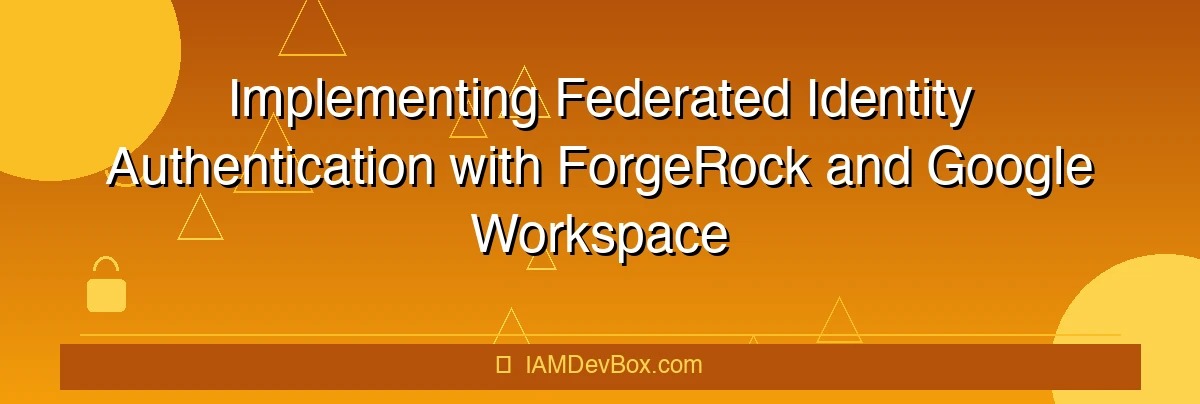Visual Overview:
sequenceDiagram
participant User
participant SP as Service Provider
participant IdP as Identity Provider
User->>SP: 1. Access Protected Resource
SP->>User: 2. Redirect to IdP (SAML Request)
User->>IdP: 3. SAML AuthnRequest
IdP->>User: 4. Login Page
User->>IdP: 5. Authenticate
IdP->>User: 6. SAML Response (Assertion)
User->>SP: 7. POST SAML Response
SP->>SP: 8. Validate Assertion
SP->>User: 9. Grant Access
In today’s digital landscape, seamless user authentication across platforms is a critical requirement for businesses. Organizations often rely on hybrid IT environments, combining on-premises solutions like ForgeRock with cloud-based services such as Google Workspace. Federated identity authentication (IdP mode) enables users to authenticate once and access multiple services, improving user experience and streamlining IT operations. This blog post explores how to implement federated identity authentication using ForgeRock as the Identity Provider (IdP) and Google Workspace as the Service Provider (SP).
Understanding Federated Identity Authentication
Federated identity authentication allows users to access multiple applications and services using a single set of credentials. This is achieved through an Identity Provider (IdP) that authenticates the user and issues tokens, which are then validated by Service Providers (SPs). In this case, ForgeRock will act as the IdP, and Google Workspace will act as the SP.
The key components of this setup include:
- ForgeRock Identity Platform: A robust identity management solution that supports SAML, OAuth 2.0, and other protocols.
- Google Workspace: A cloud-based productivity suite that integrates with external IdPs for single sign-on (SSO).
- SAML (Security Assertion Markup Language): A widely used protocol for exchanging authentication and authorization data.
Configuring ForgeRock as the Identity Provider
To set up ForgeRock as the IdP, you need to configure it to support SAML and issue tokens compatible with Google Workspace. Below is a step-by-step guide:
1. Create a SAML Identity Provider in ForgeRock
- Navigate to the ForgeRock Identity Platform admin console.
- Go to Applications > Identity Providers and create a new SAML Identity Provider.
- Configure the following parameters:
- Entity ID: A unique identifier for the IdP (e.g.,
urn:example:forgeRock). - SAML 2.0 Binding: Select
HTTP-Redirectfor browser-based SSO. - Signature Algorithm: Choose
SHA-256for secure signing.
- Entity ID: A unique identifier for the IdP (e.g.,
2. Generate and Export Certificates
- ForgeRock requires an X.509 certificate to sign SAML assertions.
- Generate a private key and certificate pair in the admin console.
- Export the public certificate, as it will be needed for Google Workspace configuration.
3. Configure User Attributes
- Define the attributes (e.g.,
email,username) that will be included in the SAML assertion. - Ensure these attributes match the expected schema in Google Workspace.
4. Test the Configuration
- Use a test user account to verify that ForgeRock can issue a valid SAML assertion.
- Tools like
curlor browser extensions like SAML Tool can help debug the configuration.
Configuring Google Workspace as the Service Provider
Once ForgeRock is set up as the IdP, the next step is to configure Google Workspace as the SP.
1. Enable SAML in Google Workspace
- Log in to the Google Admin console.
- Navigate to Security > Identity tools > SSO (SSO).
- Select Set up SSO and choose SAML as the identity provider.
2. Provide ForgeRock Configuration Details
- Entity ID: Enter the Entity ID configured in ForgeRock (e.g.,
urn:example:forgeRock). - Sign-on URL: Provide the URL where users will be redirected to authenticate (e.g.,
https://idp.forgeock.com/saml20). - X.509 Certificate: Upload the public certificate exported from ForgeRock.
3. Map User Attributes
- Map the attributes from the SAML assertion to Google Workspace user fields (e.g.,
email,first name,last name). - Ensure that the attribute names match exactly.
4. Test the Integration
- Use a test user account to log in to Google Workspace via the SSO URL.
- Verify that the user is correctly authenticated and redirected to the Google Workspace dashboard.
Real-World Use Case: Hybrid IT Environment
A company with a hybrid IT environment uses ForgeRock for on-premises identity management and Google Workspace for cloud-based productivity tools. By implementing federated identity authentication, employees can log in once to ForgeRock and access both on-premises applications and Google Workspace services seamlessly. This reduces friction for users and simplifies IT management.
Benefits of the Integration
- Single Sign-On (SSO): Users authenticate once and access multiple services.
- Enhanced Security: Centralized identity management reduces the risk of credential fatigue and improves compliance.
- Improved User Experience: Streamlined login process reduces frustration and increases productivity.
Common Issues and Troubleshooting
- Certificate Mismatch: Ensure the public certificate exported from ForgeRock matches the one uploaded to Google Workspace.
- Attribute Mapping Errors: Double-check that the attribute names in the SAML assertion match the expected fields in Google Workspace.
- Network Issues: Verify that the SSO URL is accessible and not blocked by firewalls.
- Token Expiry: Ensure that the SAML assertion includes the correct
NotBeforeandNotOnOrAftertimestamps.
Conclusion
Implementing federated identity authentication with ForgeRock and Google Workspace enables organizations to achieve seamless SSO across hybrid IT environments. By leveraging SAML and the robust capabilities of both platforms, businesses can enhance security, improve user experience, and streamline IT operations.
Extended Questions for Readers
- How would you handle multi-factor authentication (MFA) in this federated identity setup?
- What are the potential security risks of exposing the SAML assertion endpoint to the internet?
- How can you monitor and audit SSO activities in a federated identity environment?
By addressing these questions, organizations can further optimize their identity management strategies and ensure a secure and scalable authentication framework.
